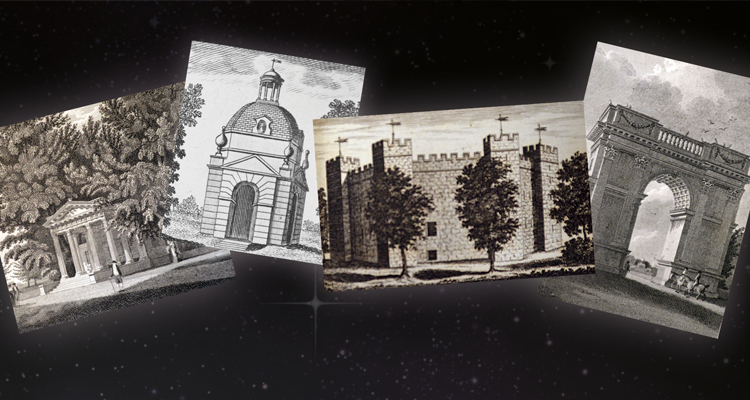I have never had any trouble getting off to sleep. I shut my eyes and that’s it – I open my eyes and it’s morning. Recently, however, I have noticed a change; perhaps it comes with age, or even the accumulation of ‘trespasses’ (BCP). Whatever the case, there are nights when I am consulting my bedside clock rather than my pillowcase. Folk remedies are suggested by my wife. These include counting sheep, which does work but it is very boring, especially when the sheep are in the care of Cousin Mark Houghton Brown (Temple 81) in New Zealand. His flock amounts to eight thousand of the woolly creatures! Old Stoics must devise their own impositions (or perhaps they are guilt free!).
My current counting scheme concerns Stowe Lodges and it works a treat. I call it Loggia Stoica and it consists quite simply of counting the historic Stowe Lodges. Starting at any point in the park and ending up at the Lodge near the Science Block, I count about thirteen or fourteen, but there may well be more.
Lodges on the Stowe Estate
Silverstone North and South
This pair are unknown to most Stoics. They were probably designed by Vincenzo Valdre and given slate roofs in the 19th century. They now have a 20th century prefab garage between them. The A43 cuts them off from the rest of the estate. In fact, the real estate value has grown enormously of late, including a college and an hotel. There is even a rumour of a racetrack for motor cars on the former RAF base – the second Duke would have loved that!
![]()
Lamport Lodge
It was brick built with iron gates. They guard the entrance from Lamport Deserted Medieval Village; by Edward Blore 1840 and they look as if they have had a battle with a tank and come off the worse!
![]()
Bourbon Tower
A circular stone tower providing accommodation for a gamekeeper. It later became the armoury for the Royal Bucks Hussars and their artillery magazine. The name derives from a visit by the French Royal Family in 1805 who were refugees from Bonaparte at the time. The black and white Lodge which can be seen from here, belonged to Captain Charles Pilgrim who lived at Akeley Wood and had charge of the Third Duke’s artillery. His modest Elizabethan style mansion lies a little further on (n.b. this Victorian estate belonged to New College Oxford) and the same applies to the Boycott, Tile House and Biddlesden estates. Lodge buildings in the classical or ‘cottage ornée’ styles seem to have been quite the fashion – so much for the Third Duke being out of money.
![]()
New Inn
This early 18th century farmhouse (1717) fulfilled a number of functions normally associated with lodges. This included provision for accommodation for the Third Duke when he was only ‘down’ for a day or two and did not want to open up the mansion. Here you could obtain your food and drink, your guidebook and hire your transport. It still serves as a visitor centre for the National Trust.
![]()
Stowe Castle Farm
This is more of a farmhouse than a lodge. It is best seen from the Doric Arch, as is the Palladian Bridge. It is an eyecatcher which has to be revealed periodically using a chain saw and a mobile phone.
![]()
Grand Avenue East and West/Buckingham Gate Lodges
These elegant little lodges and their setting were almost lost to Stowe, but were saved by Clough Williams Ellis, the School’s architect. He bought up the land on either side of the avenue and thus prevented ribbon development.
![]()
Corinthian Arch East and West
This pair of lodges is part of the Corinthian Arch and has been the principal entrance from 1773. It frames a dramatic view of the mansion.
![]()
Bellgate Lodge
This small lodge is the main visitor entrance to the gardens. Even now it performs its original function. It is hidden behind one of the two lakeside pavilions. These are not lodges in the English sense but are essential landmarks when viewed from the South Front Portico.
![]()
Water Stratford Lodge
This marks the outermost point of the landscaping to the south of the park. It was probably designed by Edward Blore. Its gates have unfortunately been removed, however a car crash recently prompted restoration of the garden railings (2022).
![]()
Oxford Gate and Lodge
This lies between the Water Stratford and Boycott Pavilions. When photographs were taken in the late 19th century the gates were intact. Some years later they were removed only to be replaced by the National Trust, using wrought iron from a German battleship scuttled at Scapa Flow.
![]()
Boycott Pavilions East and West 1734
For a number of years, they formed the principal entrance to the park and gardens with railings between them. However, the eastern most lodge was not converted into a house until the School had need of it. The western lodge was a house from its inception. Colonel Speed, a military chum of Viscount Cobham, took up residence there and from 1741 Lancelot (Capability) Brown made it his home. It now houses the Stowe kennel huntsman and his pack of 15½” show beagles.
![]()
The Garden Lodge 1839
This has performed various functions over the years and remains an oddity. Firstly, it is not perpendicular to the buildings around it and secondly it is positively ancient when viewed as the companion to the Worsley Science Centre.
![]()
Finis
Now cast aside all papers, cribs and guidebooks, settle yourself on your pillows and start counting – there – it is tomorrow already!
P.S. Sorry to wake you but we must not forget the largest lodge of them all. I mean the Mansion itself – you can go back to sleep now!
With grateful thanks to Michael Bevington whose research has transformed Stowe studies.
Anthony Houghton Brown

